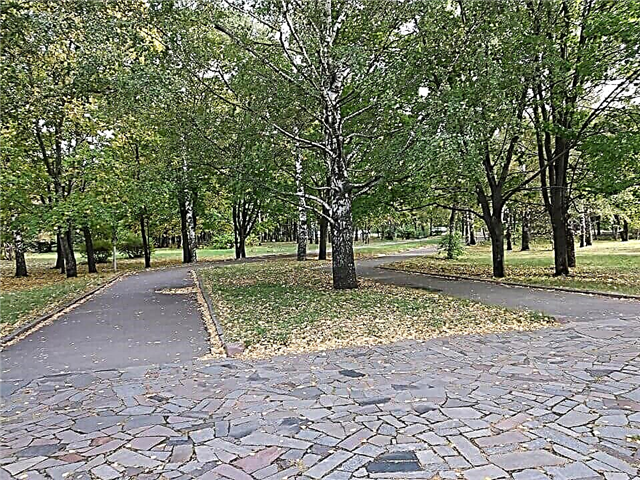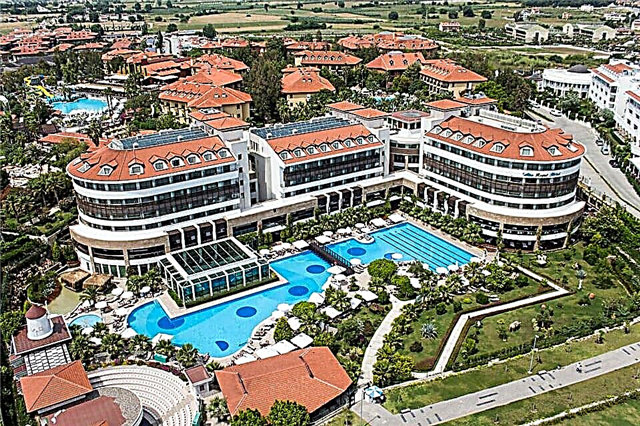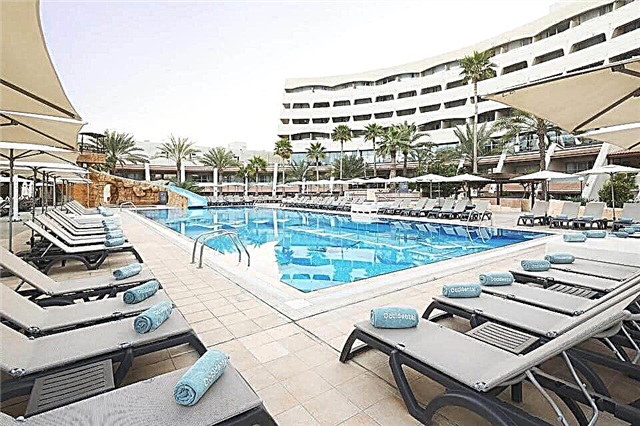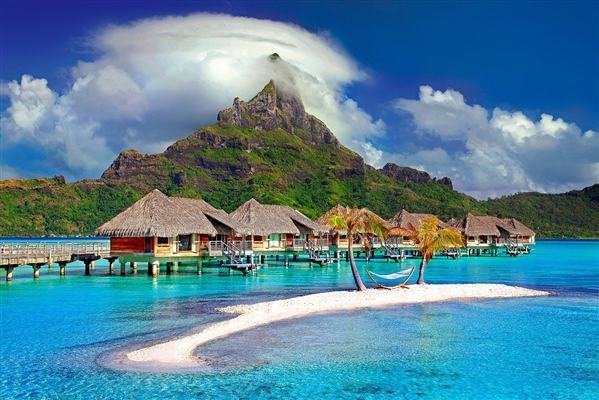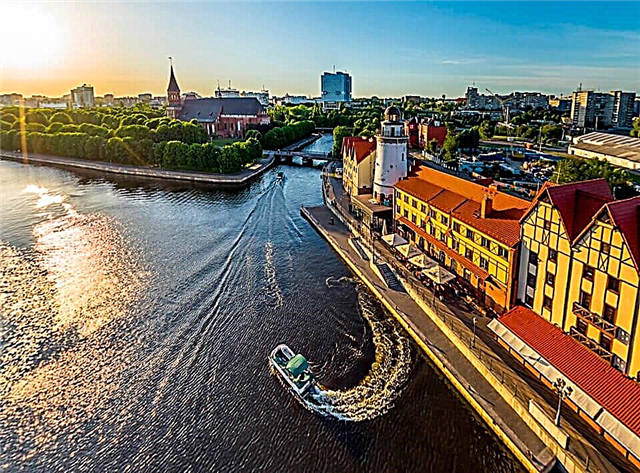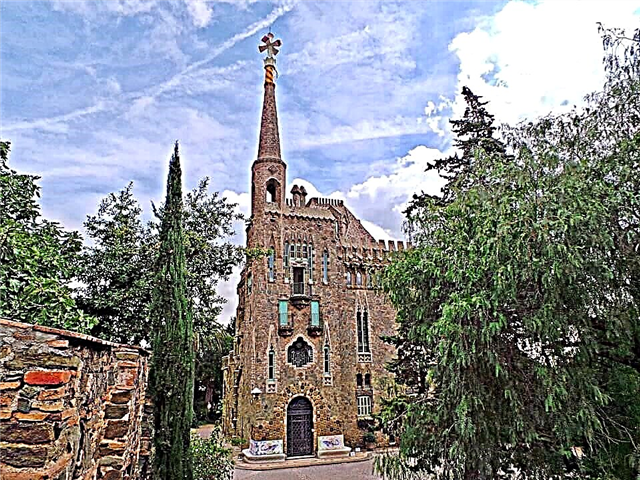The beautiful, diverse, amazing capital of Spanish Catalonia - Barcelona can rival the most famous cities in the world in terms of the number of attractions. No matter how much you come here, you always discover some new miracle for yourself, you feel some new nuance, rhythm, movement. It is not for nothing that so many great people were born, grew up and created here, who delighted and delight the inhabitants of our planet with a variety of masterpieces.
Artists Pablo Picasso, Salvador Dali, Joan Miró; unique architect Antonio Gaudi; The greatest singers of our time, Jose Carreras and Montserrat Caballe, once lived and continue to live here. Let's talk about the most important sights of Barcelona.
Ramblas

The heart and soul of Barcelona - the Ramblas stretches over 1 kilometer from the historic Plaza Catalunya to the port itself. Walking along it is a series of amazing discoveries and encounters with a wonderful past and present, captured in extraordinary buildings, outlandish structures, and historical monuments. Rambla is conventionally divided into 5 parts, each of which is interesting in its own way and worthy of admiration.

“Canaletes” is the first zone of the boulevard, named after the drinking fountain of the same name with an unusual design: a volumetric cast-iron vase, decorated with the coat of arms of Catalonia, on top is complemented by a decorative stand with lanterns of the 19th century.
Such a "zest" can be seen only in Barcelona and drink from it delicious Barcelona water, which, according to legend, will help you come back here again. There are plenty of people who want to experience it for themselves, but the fans of football "Barcelona" constantly return to the fountain, excitedly discussing the next match of the famous team.

"Rambla of the teachings" is the second zone of the boulevard, named after the university located here in the past. Although the educational institution has long been closed, the name stuck. The most fascinating sight of this section of the boulevard is the bird market opened at the former university. What kind of birds you will not see on it - from the most familiar to the most exotic! Notable for everyone will be the magnificent mansion of the former Royal Academy, built in 1894.
The pink facade with columns, with graceful stucco decorations will make you admire yourself. Now the theater is actively operating in it Poliorama, in the repertoire of which comedies and musicals that are in demand by the audience in Barcelona and tourists. This building is associated with dramatic pages in the history of Barcelona, when the battles of the Catalan authorities with the anarchists were fought, and the future famous writer J. Orwell took part in them.

The church of Our Lady of Bethlehem, the building of which is made in the style of luxurious baroque, will amaze the imagination of those walking. The central facade of the Jesuit church, built in 1680, is amazing. Despite the pogrom of 1936, which destroyed the gilded statues and frescoes, the cathedral is still very impressive with its external interiors and interior decoration.

The Rambla of Flowers - a part of the boulevard, which is a continuous flower garden, made up of many flower shops and shops - a real flower extravaganza. Walking along such a section of the street is a sheer aesthetic pleasure! In addition to the flower idyll, it is worth considering the wonderful 18th century Baroque palace of the Catalan Viceroy Palau de la Virreina.
It now houses an exhibition center, where visitors are rumored to sometimes see the ghost of a woman in a long dress. It is believed that this soul of the viceroy who has been offended by her husband who has left her cannot find refuge. This legend attracts a lot of visitors admiring the splendor of the interiors and exhibits.
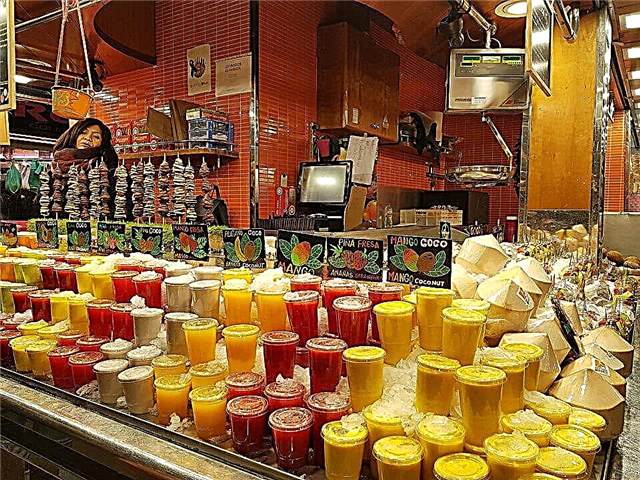
The attention of many is focused on the Boqueria market, opened on the day of St. Joseph (1840). This central gastronomic empire, similar to the Odessa Privoz, has become a cult place for the Barcelona people. Tourists also love to come here to buy local delicacies. The Rambla of the Capuchins is famous for the Umbrella House, the former mansion of Bruno Quadras, where umbrellas were once sold there. During the reconstruction, the building of the modern style was supplemented with ancient Egyptian symbols, which made it a unique structure.

The main attraction of the Rambla of the Capuchins is the Liceu Opera House - a magnificent building with 3 arched entrances, a balustrade, stained glass windows of extraordinary beauty, two stories high. All world opera celebrities have performed on the magnificent stage. After the fire in 1994, all the interiors of the theater were carefully restored within 5 years.

The Rambla of the Capuchins ends with the amazing fountain “Three Graces”, next to which there are lanterns with lamps of extraordinary design made by the young Gaudí. Rambla of Saint Monica - the final part of the boulevard, ending with the "Gate of the World" square with the famous monument to Columbus - a monumental 80-meter column.
A significant attraction here is the Saint Monica Center for the Arts, housed in a stately building of a former convent. The Center houses an art gallery with exhibitions of art masterpieces. Rambla maritime amazes everyone with its extraordinary futuristic-style walking bridge connecting the boulevard with the Maremagnum shopping center with undulating zigzags.
Gothic Quarter

This quarter stretches from pl. Catalonia to La Rambla and is represented by unique medieval buildings from the era of Octavian Augustus (14-15 centuries). Old narrow cobblestone streets perfectly convey the flavor of the Middle Ages. A walk in the Gothic Quarter is a journey through the living past, captured in buildings of Gothic architecture, one of the greatest monuments of which is the Cathedral (13th century).
This is a real architectural masterpiece, carefully restored and additionally decorated in the 19th century, so that today's descendants can admire such a structure. The cathedral houses the tomb of Barcelona's patron saint, Eulalia, in whose honor the annual Festa Mayor festival is held.

Piazza Sant Jaume is famous for 2 magnificent Gothic mansions located nearby. One of them houses the city hall, the other houses the Parliament of Catalonia. The chapel of St. George, captivating with the luxurious beauty of the facade, decorated in the artistic tradition of Catalan Gothic. On the King's Square there is a unique building of the Museum of the History of Barcelona, assembled from separate parts transferred here, where the remains of Roman buildings, other items of ancient life and tools of labor have been preserved.
The undoubted decoration of the square is the King's Palace, in which the throne room is unusually beautiful, the chapel of St. Agates and an architectural example of the Renaissance - the tower "Ray Marty". The Frederic Mares Museum presents a collection of outlandish gizmos and household items collected by Mares himself: various figures for sacrifices, keys of all kinds of modifications, walking sticks, umbrellas, travel bags, etc.

At the intersection with st. The paradise is a genuine rarity - 4 columns left over from the ancient Roman temple of Augustus. To see them, you need to go to the excursion bureau, where monumental witnesses from the times of the Roman Empire rise right outside the door. A very interesting place to visit is the Jewish Quarter - a kind of museum of the life of Jews until the 15th century. There are many shops selling old books, souvenirs and Jewish antiques here. Those wishing to get acquainted with the life and history of Catalan Jews can visit the Cal Info Center.

Pine Square actually represents the unity of 3 squares, gradually replacing each other. The name of two of them contains the word Pi - a shortened version of the word "pine". This tree is considered a floristic symbol and an indispensable decoration for Placa del Pi, hence the name.But the true decoration of the Piazza Pines is the Church of Santa Maria del Pi. The Gothic entrance, arched vaults of narrow windows, octagonal side towers, openwork window-rosettes - everything is full of grace and nobility inherent in the Catalan Gothic style, it looks irresistibly beautiful and majestic.
Fast track ticket for the Sagrada Familia - 20 €
Entrance ticket to Park Guell - 10.75 €
Casa Batlló ticket and video guide - € 24.50
Hola BCN: public ticket transport for 2,3,4 or 5 days - 15 €
Ticket to PortAventura park and transfer - 69 €
Ticket to the parks "Port Aventura" and "Ferrari Land" - 55 €
Ticket to Tibidabo Amusement Park - 28.50 €
Skip-the-line ticket with audio guide to Casa Mila - € 22
1 or 2 days hop-on hop-off Barcelona city tour - 30 €
Casa Batlló

All architectural creations of a unique architect endowed with a fantastic artistic vision are unique masterpieces. An example is Casa Batlló - the result of the restructuring of the old Tenement House (1875) by the brilliant architect-designer Gaudí, who redesigned and decorated 2 facades in a new way, making the house a work of art. There are almost no straight lines in the design, all the details smoothly flow into one another, creating an incredibly beautiful symbolic picture, in general, reminiscent of a fairy-tale dragon with scales iridescent in all colors.
Even the numerous columns located on the first 2 floors are similar in shape to bones, for which the people called the building the House of Bones. This is the first creation of Gaudí in a similar style, which laid the foundation for a new direction in the creation of his subsequent masterpieces, which have become inimitable unique. To fully imagine the amazing appearance of the wonder house, you need to see it at least once.
Mila's house

This house is the last of the unsurpassed masterpieces of the divinely gifted architect, who he created by order of the owner of the apartment buildings Mila (1906-1910). The great Gaudi created an architectural perfection from a prosaic order, which has become the national pride of not only Barcelona, but the whole of Spain. The architect took the mountain as the basis for the masterpiece, deciding to build a building of stone in the art nouveau style.
External and internal interiors are striking in their non-standard beauty and originality of execution. Smooth lines and undulating curves were also used here, giving the massive 6-story building an airy lightness, although they used mainly steel and concrete.
Every detail in Mila's décor is a work of art: balcony grilles, colorful stained-glass windows, chimneys in the form of wonderful futuristic sculptures and even a railing on the roof. To see such a miracle in reality is great happiness!
Park Guell

In the fabulously extraordinary Park Guell, spread over 17 hectares, a lot has also been done according to the project of Gaudí, so miracles begin from the very entrance: houses that look like painted gingerbread, covered with white glaze; a giant lizard made of colored mosaic, spread out on a green lawn. The entire territory of the park is filled with truly magical structures, mysterious objects and extraordinary attractions.
Everywhere you can feel the talented hand of Gaudí, who first built several private houses here at the request of Guell, who planned to sell them along with plots of land. The plans did not come true, and then one of the houses was bought by Gaudi himself, in which he lived until his last days, turning the rest of the site into a wonderful amusement park and monuments of unusual architecture.
Cathedral

The main attraction of Barcelona and all of Spain is a unique religious site - the Cathedral, declared a cultural and historical monument and a national treasure of the state. The building, which was under construction for a long time, embodied the features of several architectural styles and acquired an unusually beautiful appearance, combining the strict grace of the Gothic, the majestic monumentality of the classics and the luxury of the Baroque. The Catalan Gothic façade was finished at the beginning of the 20th century, and the construction of the cathedral on the site of the Roman basilica began in 1298 - the unique structure was brought to perfection over 7 centuries.

The majestic cathedral rises with its bell towers almost 100 m. On the facade there are sculptures of the characters of the Bible, among them the statues of Christ and the apostles. Water drainage gutters are made in the form of sculpted gargoyles - mythical creatures fighting demons.
Here is the tomb of the patron saint Eulalia, a magnificent organ has been installed for organizing concerts of organ music (every month). 6 gates lead to the temple, where crowds of tourists flock to admire the amazing interiors of the religious and architectural shrine.
Sagrada Familia

The Sagrada Familia, a fantastic brainchild of Gaudí, is visible from afar with its delicate towers, literally ascending to heaven. Looking at this amazing structure, it is hard to believe that it is in reality, and not presented in the form of a mirage - the architecture of the cathedral is so unusual. From a distance it looks like an openwork outlandish casket, carved by a thin jeweler from a silver ingot, and only close up one can see individual structures of the temple ensemble.
The construction of a unique structure, on the design of which Gaudi worked for several decades, has not yet been completed, but it is only planned to be completed by 2026. Elements of many architectural styles are intertwined in the striking interiors of the fabulous temple: Gothic, Baroque, Art Nouveau, Moorish motives and Art Nouveau. Now, talented architects continue to work on the final completion of the ingenious project of an extraordinary designer, embodying their creative ideas into a masterpiece of architecture.
Aquarium

It is difficult to call such an impressive structure in terms of volume and variety of species of underwater inhabitants an aquarium. Rather, it is a whole scientific and educational world for the study of the Mediterranean aquatic fauna. In fact, there are 14 aquarium ecosystems here: rocks, sandy areas, algae islands, coral reefs, underwater caves, etc.
The many-sided variety of marine life amazes even seasoned underwater photography enthusiasts. Here are the rarest specimens of underwater inhabitants of the deep sea, from microscopic fish to huge sharks. Holders of a diver's certificate can swim in the neighborhood with exotic inhabitants of the aquarium.
Agbar Tower

But Barcelona pleases not only with old mansions, palaces and temples. It also contains modern masterpieces of high-tech architecture, such as the Agbar Tower. This structure, similar in shape to a giant cucumber, has 38 floors (4 of them are underground), the total height is 145 m. A unique structure was erected as the office office of Barcelona's Vodokanal, but when they saw all the extraordinary splendor and shining beauty of the tower, they decided organize a 5-star hotel. While the preparatory work is underway, the Agbar Tower, sparkling with rainbow colors (16 million shades), has become a supernatural decoration of Barcelona.
The modern masterpiece combines the striking beauty of design and the technical innovation of the building. Here, an efficient heating and ventilation system has been thought out, achieved by means of two-layer walls. 1st layer of walls - concrete shell, faced with sheet metal brightly colored in blue, red, pink, blue tones with built-in LED bulbs (4000).
The 2nd layer consists of frosted glass blinds, which helps to keep warm in winter and cool in summer. The tower looks like a phantasmagoric kaleidoscope: during the day it sparkles in all shades under the sun, and in the evening it shimmers like a fabulous firebird in electron beams. Hundreds of visitors with great pleasure walk around Agbar along the charming alley located nearby.
Palace of Catalan Music

It's not a secret for anyone how the Catalans love their land, how sacredly they honor and cherish their traditions, culture and art.The symbol of this is the Barcelona Palace of Catalan Music, where everything literally breathes with love and patriotism, from the external architecture a la Art Nouveau to the spiritual and aesthetic direction of concerts held in its magnificent halls.
This is the main cultural center of today's Barcelona. Although the building itself was erected back in 1905-1908, it has not lost the features of modern modernism and is rightly considered the pearl of this architectural style. The palace is full of active life, various concerts, conferences, exhibitions and congresses are held almost every day.
Spain square

The area of Spain is 34 thousand square meters, is the second largest and most important area in Barcelona and was opened for the 2nd World Industrial Exhibition in 1929. The architect José Puig y Cadafalc designed the Plaza de España by analogy with the main Venetian Piazza San Marco. The square is decorated with 47-meter columns leading to the exhibition center, light and music fountain and the National Art Museum of Catalonia.
Nearby is the round brick building of the Arena shopping center, in which bullfighting was held until 1977. For 1 euro, an elevator takes visitors to the roof of the shopping center, from where a wonderful view of the fountain dedicated to the waters surrounding the Iberian Peninsula opens. The red L1 and green L3 metro lines and the electric train that brings tourists to Montserrat mountain lead to the Plaza Espanya (Placa Espanya).
National Art Museum of Catalonia

The National Art Museum of Catalonia was opened in 1934 in the building of the National Palace of Barcelona. The palace is located on the Montjuïc mountain and is surrounded by extensive parkland. At the foot of the National Museum, there is a Magic Light and Music Fountain known for its evening show programs. The Romanesque hall of the museum displays a collection of examples of Catalan icon painting from the 12th to 13th centuries, including frescoes, woven icons and wooden architecture.
In the Gothic hall there are canvases and sculptures by Catalan artists of the XIV-XVI centuries. The Renaissance era contains works by French, Italian and Spanish masters, of which the most significant are the works of El Greco and Velazquez. The exhibition halls of the 19th and 20th centuries house paintings by modernist and avant-garde artists.
Opening hours - all days except Monday and public holidays: from June to September from 10:00 to 18:00, from October to May from 10:00 to 20:00. The entrance ticket costs 12 euros. For 4 euros, the museum offers an audio guide in eight world languages, including Russian.
Montjuic

The 173-meter peak is not just a mountain, but a real springboard for various attractions, quite ancient and modern. Montjuïc, whose territory is now decorated with bright lawns and flower beds, has a museum, whose exhibits in the form of knightly armor, muskets, cast-iron cannons will make you feel the atmosphere of a former military fortress.
From the gray walls of the castle, you can head to the enchanting symbol of modernity - the Singing Fountain, admire the cascades of rainbow jets and splashes that change shades in time to the music. Constructed in 1929, it was refurbished in 1992 and shines better than ever. The colorful show attracts many tourists and locals.

There are 2 museums here. The National Museum of Art displays ancient frescoes, temple altars, paintings by Picasso, Rubens, Goya and other classics of painting; unique sculptures of the Renaissance, ancient coins and medals. The J. Miró Museum exhibits the avant-garde works of an extraordinary artist.
In addition to paintings and sculptures, his fountain "Mercury" is impressive, exhibited in an airtight glass cube, because instead of jets of water, silvery cascades of liquid mercury sprinkle out of it. The main attraction of Montjuic is the Olympic Stadium, open for the Summer Olympics-92. 2 graceful equestrian statues, like guards, guard the entrance. There is something for the audience to see: the Museum-Gallery, sports facilities of the Olympic Ring and much more.
Spanish village

Near the Montjuïc mountain there is an interesting attraction of Barcelona, loved by many tourists - the Spanish village, a kind of Spain in miniature, where each of its regions is represented by some characteristic object. Created a village for the 1929 Barcelona World's Fair.
A whole group of architects, artists, designers traveled to the Spanish provinces, choosing the most significant buildings and structures to create the overall appearance of the country on 49 thousand square meters. m. There are 117 houses, various workshops, shops, temples and bars, built in full accordance with the originals.
Nearby were the Valderrobles municipality building and the Carmelite church, a house from Cantabria and the Casa de los Ngulos Aragonese tower, in reality separated by hundreds of kilometers. And in the workshops, you can learn the art of blowing glass, weaving intricate lace, making pots, chocolate and even jewelry. Here you can also buy memorable souvenirs or practically useful things. The gambling show "flamenco show" attracts crowds of people of all ages in the evening.
Mount Tibidabo and the Temple of the Sacred Heart

7 km from Barcelona is the mountain “Tibi dabo” (I give it to you). At an altitude of 512 meters, Jesus looks down from the mountain with outstretched arms. The seven-meter sculpture was created by Jusepe Mireta and installed on the tent of a temple with an amazing history.
After the death of her husband, the banker's wife, the pious Dorothea de Chopitea, distributed money to the poor, but donated most of the funds for the construction of the chapel (events of the mid-19th century). People were drawn to the mountain, which aroused the envy of wealthy Barcelona residents. They wanted to own the mountain for business. The Catholic Council of the Order of the Knights got ahead of the magnates, bought the land and handed it over to the priest John Bosco.

The project of the temple was created by the marquis and architect Enric Seigneur. He also supervised the construction, but during his lifetime he did not complete the matter. However, the construction was continued by the son of Enric Seigneur. In 1961, construction was completed. The most interesting thing is that the dreams of entrepreneurs also came true on the mountain: next to the majestic Church of the Sacred Heart, there is an amusement park, with a cafe, a restaurant and a museum of dolls.
The Tibibas bus will take you up the mountain for 2.95 €. Leave Bank Caja Madrid (20 min intervals). The second option is a funicular (4.1 €) from the station. Funikular del Tibidabo. In the temple you can climb to the observation deck “At the feet of Jesus” for 2.5 € during the day, except for the hours of worship. They start at 8:00, 12:00, 17:00 and 19:00.
Montserrat mountain and monastery

The mountain is 1236 m high and 10 km long and consists of bizarre sculptures of natural origin. Many rocks are given names: "Skull", "Mummy", "Pregnant Mountain", "Bishop's Belly". But they go up here to bow to the wooden Madonna and Child with gilding, called "La Morenets" (translated as "dark-skinned"). The meter-high statue helps with infertility, fulfills other requests.

According to legend, the Madonna was sculpted by St. Luke (50s A.D.). The location of the shrine was not known until the 10th century, but the shepherd boy unexpectedly stumbled upon the statue. The halo of rays and the singing of angels suggested. The monastery of the Holy Cave "Santa Cova", erected on the site of the find in 1025, surrounded the hermitages of St. St. Martina, Petra, Iskle. And in 1592, Abbot Oliba built a majestic basilica according to his own design, combining features of the Gothic and Renaissance. At the end of the 18th century, the monastery of Montserrat was so rich that it became a tasty morsel for Napoleon Bonaparte. The settlement of the monks was taken by storm, but the invaders did not get the golden utensils, as they managed to hide it.

The current approaches, observation platforms, hotel and monastery houses were built in the 20th century. The openwork arcades are set in such a way that the path of the pilgrims is in the shade, while not blocking the magnificent view of the Catalan capital Barcelona. The monastery has a museum with a collection of paintings by Spanish masters Caravaggio, El Greco, Monet, Degas, Picasso and Dali. There are also sculptures, jewelry, Orthodox icons.
On Sundays, during the service at 1 pm, the world's best Benedictine choir "Escolania" sings.
From metro lines nos. 1 and 3 to Montserrat, take the R5 train to the Montserrat-Aeri or Monistrol de Montserrat stations. From the stations, a funicular goes up to the monastery. A single “Trans Montserrat” ticket costs 29.50 €.
Picasso Museum

The most visited museum in Bareselon is located in the Gothic mansion of Berenguer d'Aguilar (15th century) on rue Moncada. The museum was opened in 1963 at the initiative of the painter's secretary Jaume Sabartes. The number of exhibits is 3800. Here you can see a series of the master of 1957 "Doves", ceramics signed by Picasso, gifts to the museum from the artist's widow Jacqueline, paintings and graphic works of the so-called "blue", "pink" and "cubist" periods, imitation of Velazquez, famous harlequins and columbines of the great Spanish painter and innovator.
Montcada: 15 - 23, 08003 Barcelona. You can get there by buses No. 17, 40, 45, 19 - stop Via Laietana or No. 39, 51 - stop Passeig Picasso. The museum is open six days a week: from 9:00 to 19:00, (on Thursdays until 21:30). Monday is a day off. The ticket price is 7 €, but on Thu from 18:30 until closing - free admission.
Camp Nou Stadium

Built in 1957, the stadium seats 99,354 spectators and is the largest football arena in Europe. The authorship of the project belongs to the architect Francesc Mitjans. Before Francesco, the stadium was expanded (in 1981) for the 1982 FIFA World Cup.
Then the "Camp Nou" accommodated even more spectators - 120 thousand. The 1992 Olympics made their own adjustments: due to the new requirements of UEFA, the seats without seats were removed, but the stands became more comfortable, with a better view of the playing field. The British firm Foster and Partners won the tender for reconstruction of eighty well-known firms.
The stadium is so huge that even at the games of the main idol of the Catalans - the Barcelona club - it is half full. The Club Museum operates at the stadium. It was founded in 1984 at the initiative of the country's President Lewis Nunez. The exposition area is impressive: 3.5 m2. Everything is exposed. From butts with a leg that scored a goal - to cups and picturesque portraits of champions.
Take the metro to the station. Collblank (blue line # 5). The stop is called: Estadi del Futbol Club Barselona, street de Joan, 23. The museum is open from 10 to 18.30, in summer from 9.30 to 19.30, on Sundays from 10 to 14.30. The cost of the examination is 25 €. The inspection includes a visit to the stands, changing rooms, a walk on the lawn of the playing field.
Boqueria market
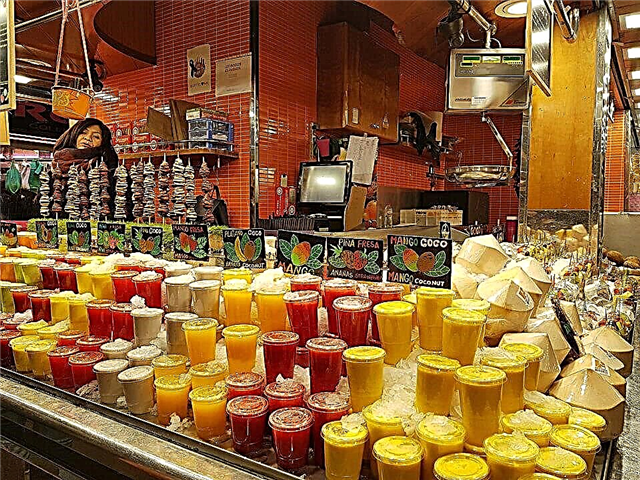
On the pedestrian street La Ramblas of Barcelona, there is the Boqueria covered market, which has existed since time immemorial as a suburban market. In 1237, the territory that became part of the city began to be improved. The current look of the market was created by the architect Mas Vila in 1853. The galleries are named “Saint-Jouser” after the saint on whose day the first stone was laid. But the new name did not catch on. In 1911-1914. fish rows were completed here, gas was installed, refrigerators were installed.
Before lunchtime siesta, absolutely all merchants work, so you can see and taste the variety of Catalan gifts in one place. The market is open from 8:00 to 20:30. Walk from Avenue Columbus towards the Liceu Theater and the Wax Museum (Museu de Cera). From the old port - 1 km. To pl. Catalonia buses 22, 42, 47, 58, 62, 66, 67, 68.
Old port

The beginning of Port Vell dates back to the docks of King Pedro III (VIII century), but the existing marinas are the legacy of another ruler, King Juan II of Aragon (13th century). Modernist bridge over the river. Llobregat was built for the 1992 Olympics. The wonderful place for walking is paved with boards, so vacationers here literally chill out on a hot day. And at night, crowds admire the swaying of boats and yachts, sitting at tables in a cafe or leaning on the railing at the very edge of the water. Near the Old Port there is the metro station of the third line Drassanes.
Plaza Catalunya

Plaza Catalunya was formed on the site of the former city wall, which was demolished in the 19th century to expand the city's boundaries. The main square is 50 thousand square meters and was made according to the project of Ildefons Kerd from granite with a pattern in the form of sunbeams. It is decorated with bronze sculptures and is surrounded by commercial banks.
There are three fountains on the square, one of which is drinking. A shuttle bus arrives to Plaza Catalunya from the airport, there are four metro lines Urgunaona, Universitat, Passeig de Cracia, Catalunya and a commuter train stops. Sightseeing buses of the “City tur” network stop - the bus painted in blue makes a longer sightseeing route, the fare in it is 28 euros per day.
You can go straight from the square:
- to the pedestrian street Portal de L'Angel with a lot of cafes and shops
- to La Rambla, which leads to the seaside
- to the shopping center El Corte ingles
It is important that until recently there were many pigeons in the square, but the city authorities banned attracting and feeding birds, citing sanitary standards.
Monument to Christopher Columbus

The monument to the Spanish navigator Christopher Columbus was erected in 1888 in the port of Barcelona on Placa del Portal dela Pau (Drassanes metro station). Its construction is timed to coincide with the opening of the 1st World Industrial Exhibition and was carried out by a group of Spanish artists and sculptors. The monument is an octagonal pedestal on which four figures are erected representing Catalonia, Castile, Aragon and Leon.
The lower bronze bas-reliefs tell about Columbus's travels to the New World, and the sculptures on the monument - about the people who took part in organizing the expeditions. On a 60-meter stele, there is a 7-meter-high sculpture of Christopher Columbus pointing with his right hand towards the sea. Inside the hollow stele, there is an elevator for 3 people, which takes visitors to a circular observation deck. The cost of one lift is 5.4 euros.
The lift operates from 8:30 to 19:30 from November to February, and from 8:30 to 20:30 from March to October, except December 25-26, January 1 and 6. Interestingly, in 2012, a group of tourists ended up at the top of the monument during an elevator breakdown, and since there is no staircase inside the stele, the travelers were safely lowered to the ground using a crane.
Next to the Christopher Columbus monument, there is a cable car that takes tourists to Montjuïc.
Monastery of Santa Maria de Pedralbes

The monastery was founded in 1327 by King Hame II and his fourth wife, Queen Elisenda de Moncado. After the death of her husband, Elisenda lived in the palace, which she built next to the monastery and remained there until the end of her days. The queen's tomb is divided by a church wall and is decorated with two sculptures: one of them represents Elisenda in royal attire, the other in monastic vestments.
In 1931, the Monastery of Santa Maria de Pedralbes was given the status of a historical and cultural monument. The living and living conditions of nuns (Clarice) from the Order of Saint Clara were recreated in the Monastery de Pedralbes in their original form: low cells, kitchen, refectory, living rooms, warehouse and biblical paintings on the walls.
The monastery was designed in the Gothic style and is currently a functioning nunnery. The well-groomed orchard located in the inner courtyard of the monastery deserves special attention. The Monastery of Santa Maria de Pedralbes is located at 9 Baixada del Monestir (Reina Elisenda metro station) and is open to visitors from 10:00, seasonal:
- from April to September - Tue-Fri until 17:00, Sat until 19:00, Sun until 20:00
- from October to March - Tue-Fri until 14:00, Sat-Sun until 17:00
Tickets cost 5 euros, on Sunday after 15:00 - admission is free.
The monastery is closed every Monday and on the following days - January 1, May 1, June 24, December 25 and Good Friday.
Bellesguard Tower

Bellesguard Tower was built in 1917 as a residential building (Figueres house) on the site of a medieval castle located at the foot of Mount Tibidabo. Architect Antoni Gaudí developed the design of the building and took part in the first stages of construction. Completion of work on the construction of the tower belongs to his student Domingo Sugranes.
The deliberate elongation of the building and the spire, with the "signature" Gaudi cross, visually increases the scale of the building.There is a hidden symbolic meaning in the details and cladding of the house, which manifests itself in the exterior and interior decoration of the building, and the magnificent spiral staircase leading to the upper floors offers visitors a wonderful view of the city. Located at Carrer de Bellesguard, 16 and is open to the public on Tue-Sun from 10:00 to 15:00. Tickets cost 9 euros.
Maritime museum

The Maritime Museum is located on the territory of the ancient royal enterprises for the production and repair of ships - the Drassanas shipyards, which belong to the Gothic buildings of the 14th century. The museum was created in 1936 to disseminate maritime culture among the population and invites visitors to get acquainted with the figures of ship caryatids, a collection of navigational instruments and devices, models and models of ships of the Barcelona Naval School.
The most interesting exhibits of the museum include full-size replicas of a submarine, sailing ship and galley.
The Maritime Museum is open at Avinguda Drassanes daily from 10:00 to 20:00, except December 25, 26, January 1 and 6. The price of tickets, including a visit to the board of a three-masted schooner, is 10 euros. Every Sunday after 15:00 - entrance to the museum is free.
Orth's Labyrinth

The oldest park in the city, the Horta Labyrinth, was founded in 1791 by the Marquis Joan Desvalls and expanded by his descendants in the middle of the 19th century. Currently, the park is a city museum and is divided into two gardens. The neoclassical garden consists of three terraces and includes sculptures of ancient Greek gods, grottoes, a natural reservoir and a 750-meter labyrinth of sheared eucalyptus trees 2.5 meters high.
In the romantic garden, rare tree species grow, green areas and flower beds with exquisite flowers are equipped, a waterfall falls. The park area covers an area of 9.1 hectares and is surrounded by woodland. In the park "Labyrinth Orta" only walking is allowed, and the number of visitors is limited to 750 people at a time. The former palace of the Desvalls family houses a design and maintenance facility for garden labyrinths.
The park is located on Passeig dels Castanyers street, 1-17 (Mundet metro station), it is open daily from 10:00 according to the seasonal schedule: from November to February until 18:00, in March until 19:00, in April until 20:00, from May to September until 21:00. The entrance ticket costs 2.17 euros.
Egyptian Museum

The Egyptian Museum was created by businessman and Egyptologist Jordi Clos Llombart based on his collection of Egyptian artifacts. The museum is located on street Valencia, 284, is open 362 days a year and has an area of 2.0 thousand square meters. It is based on three floors and includes an exhibition of 1,100 permanent exhibits, a library and classrooms equipped with computers with information files.
The halls display superbly executed sarcophagi, jewelry made of gold and precious stones, sculptures, open tombs with mummified bodies of pharaohs and their relatives, death masks of the rulers of Egypt. Guided tours with an audio guide or a professional Egyptologist are available.
Opening hours from June 25 to September 11 from 10:00 to 20:00, on other days of the year the exposition work schedule is the same, adjusted for lunchtime from 14:00 to 16:00. In any season, the museum closes on Sunday at 14:00 and on Saturday at 20:00. The Egyptian Museum is closed on December 25, 26, January 1 and 6. Night tours and shows are organized by appointment, accompanied by tasting of fruits and vegetables grown on the banks of the Nile. On Saturday admission to the museum is free.
Joan Miró Park

Joan Miró Park is located next to Plaza de España (Carrer d'Aragó street, 2) and is located on the site of the city's former slaughterhouse. The park area is divided into a green area and a site with a sculptural composition. In 1983, the sculptor Jean Miro, in collaboration with Joan Artigas, presented to the public a phallic statue "Woman and Bird" over 20 meters high and decorated with multi-colored tiles. The word "bird" in Catalan is interpreted as a term for the male reproductive organ.
Miro, in his creation, repeated the form of ancient Roman sculptures of the 2nd-3rd centuries, made on this theme. The park is intended for recreation, walking and cycling. The landscape arrangement of the lower tier is represented by an artificial reservoir, palm alleys, gazebos, flower beds and densely planted pine trees. The park is free to visit.
Museum of the Olympic Games and Sports

The Joan Anthony Samaranch Museum of Olympic Games and Sports is located in the Olympic Park on Montjuïc and is dedicated to the 1992 Olympic Games in Barcelona. A symbolic alley with the prints of the Olympiad winners leads to the museum. The exposition covers an area of 4.0 thousand square meters and presents visitors with authentic cups, medals and personal belongings of world-class athletes.
Olympic torches, racing cars, boots, bicycles are all original exhibits of the museum.
For the convenience of inspection, the halls of the museum are equipped with audiovisual and multimedia devices. Open every day except Monday and public holidays January 1, May 1, December 25 and 26. Opening hours from 10:00 to closing depending on the season:
- October-March - Tue-Sat until 18:00, Sun until 14:30
- April-September - Tue-Sat until 20:00, Sun until 22:30
The entrance ticket costs 5.8 euros.
CosmoCaixa Science Museum

The CosmoCaixa Museum is located at 26 Isaac Newton and is considered one of the most visited in Barcelona among adults and children. The tour of the museum begins with watching a space video program at the planetarium and continues on six floors of the exposition. Visitors are presented with a laboratory of polar explorers and a fragment of an iceberg, a hall of microbiology, which tells about the appearance and development of living things on the planet, local history exhibits and geological layers of the earth's crust, a tropical forest that recreates the Amazon ecosystem.
In the children's rooms of the museum, the youngest visitors are given the opportunity not only to see, but also to touch interesting exhibits. Opening hours daily from 10:00 to 20:00 except Monday. Days off December 25, January 1 and 6.
The price of a ticket to the museum is 4 euros, for children under 16 years old admission is free. On Sundays, admission is free for all categories of tourists.

